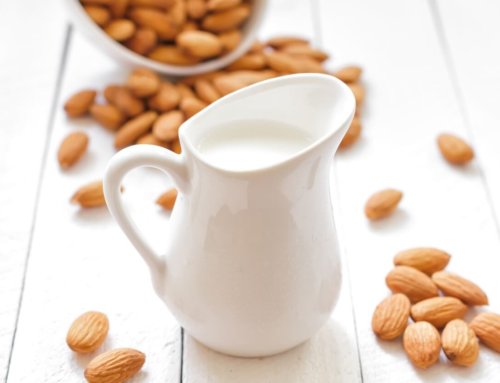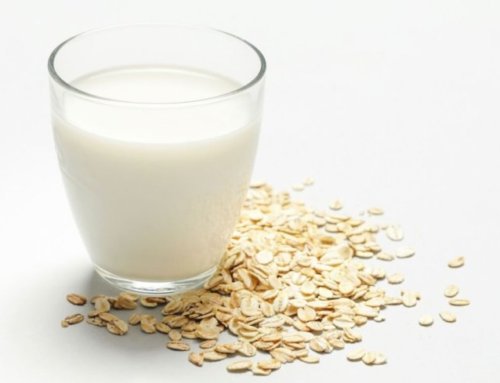Project Description
Soy Milk Processing Line
Description Of Soy Milk Processing Line
- Soy milk is a vegetable protein beverage made from soybean as the main raw material, which is prepared by soaking, grinding, extracting pulp, pre-cooking and deodorizing, and adding water and sugar liquid to the milk, then blending and sterilization and filling into small consumption packages.
- Soy milk beverages are not only high in fiber, high in protein, high in vitamins and minerals, but also low in sugar. They are ideal substitutes for animal protein dairy products and are widely popular in East Asia and Southeast Asia.
- Aiming at the problem of beany flavor during the processing of soymilk, we use hot water soaking and refining to inactivate oxidase activity, and add flavor substances such as spice cocoa during the blending process to mask the beany flavor, which can effectively remove the beany flavor in the soymilk.
- For the FAQ of the soy milk processing line, please take reference from this page. We also summarized the quality problems and solutions during soy milk production.
- The complete set of soy milk processing equipment includes soybean soaking and cleaning unit, vacuum bean suction machine, soybean milk triple refining and separating unit, special vibration sieve, soy milk continuous pre-cooking unit, ingredient mixing system, finished product temporary storage tank, high-pressure homogenization Machine, CIP online cleaning system, UHT ultra-high temperature sterilization unit (special tube type for soy milk), aseptic finished product temporary storage tank, soy milk filling and packaging system, RO water treatment system.
- we adopt UHT ultra-high temperature sterilization unit dedicated to plant protein, which is completely heated and enzyme inactivated according to the characteristics of soy milk, and online deodorization. It maintains the fresh taste of the product, no beany smell and bitter taste, and the produced product has a good taste.
- The commercial soy milk production process involves soaking and grinding soybeans into a slurry, heating the mixture to denature proteins and remove beany flavors, separating solids from liquid, adding additives such as sweeteners and flavors, homogenizing and degassing soy milk, pasteurizing, and packaging the resulting soy milk.
- Soybean processing adopts automatic screening and cleaning, vacuum automatic suction and delivery, which eliminates the trouble of manual handling and can be continuously produced, which greatly improves production efficiency and speed, and saves labor and labor intensity.
- The capacity of the soy milk production line is available from 500LPH-5000LPH. The final packaging of soy milk can be filled into bottles, tinplate cans, stand-up pouches or aseptic cartons.
- The production line equipment is made of food-grade SUS304, and is equipped with a CIP online cleaning system to ensure that the soy milk produced meets food hygiene conditions.
- The whole line is fully controlled by PLC, which saves labor and has high production efficiency. The equipment can be configured according to customer needs to produce pure soy milk, soy milk beverage line, and compound vegetable protein beverage line.
Soy Milk Processing Line End Products And Package
The soy milk PH value is between 6.7 to 7.3, The color of soy milk is milky white or light yellow, without beany flavor or bitter taste. The end products can be filled into small bottles or tin cans, and the shelf life is 3 days to 7 days with pure soybean milk. For the carton soybean milk, the shelf life is 6 months to 9 months. And for blended soybean milk, the shelf life is 12 months.
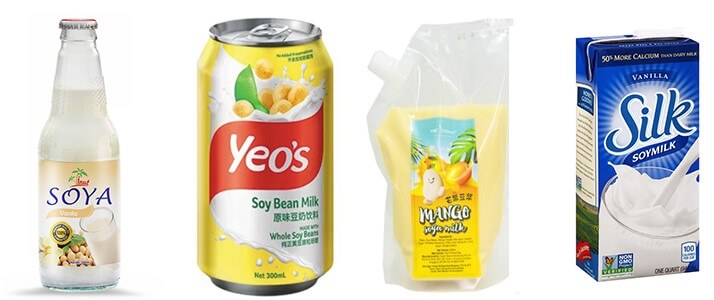
Soy Milk Processing Line Classification
High solids and high fiber soy milk: Made by water extraction from whole soybeans, using soybeans and water ratio of 1:5, where most of the dietary fibers from soybeans are present in the final soy beverage.
Pure soy milk: An emulsion made by extracting protein and other ingredients from soybeans with water and removing the dregs. The solid content of soybeans is not less than 8%. Nutritional fortifiers can also be added.
Blended soy milk: Add sugar, refined vegetable oil, minerals, vitamins, etc. to pure soy milk. The milky beverage is prepared with soy solids content of more than 5%.
Sour soy milk beverage: pure soy milk is fermented with lactic acid or added with sour agent, sugar, emulsifier, and other auxiliary materials to prepare soy milk beverage, soy solid content is not less than 4%.
Juice soy milk beverage: A beverage prepared by adding concentrated juice or original juice and other flavor ingredients to pure soymilk, in which the juice content is not less than 2.5%, and the soybean solid content is not less than 2%.
Soya Milk Powder: Soybeans are refined and pulped, slag slurry separation, vacuum concentration, compound enzymolysis, spray drying and other processes to make soybean powder containing hypotensive functional peptides. The specific soya milk production flowchart are as follows: Soybean material selection → soaking → refining → pulp residue separation → soy milk sterilization and deodorization→ blending and preparation →vacuum concentrating → spray drying → sieving powder → packaging → finished product
Soy Milk Processing Line Technological Flowchart
Choose the fresh soybeans with bright color and full grains as raw materials, unload them into the soybean cleaning tank to clean off the attached dust and microorganisms, and then use the vacuum bean absorber machine to lift the cleaned soybeans to the soybean soaking tank, after soaking in hot water at 60°C with a ratio of 1:3 soy to water for 1-2 hours to inactivate the enzymes, it will be lifted to the soybean refining and separator unit, and the water will be heated while refining. At the same time, the okara will be separated during the refining process. Then we got soy milk. However, in order to remove the beany flavor in the soy milk, the obtained soy milk needs to be cooked in hot water at 90-95°C. Finally, the auxiliary materials such as sugar, emulsifiers and flavor substances are added to the mixing tank according to the ingredient list, after all ingredients are sufficient mixing and dissolving, the soy milk is homogenized, sterilized and degassed, and then filled into a bottle or stand-up pouches. After filling, the bottles, cans or pouches will be sent to retort sterilizer(121℃ for 15-30 min) for secondary sterilizing.

Key Machine Of Soy Milk Processing Line
Soybean washing machine
Use drum cleaning equipment to clean soybeans, which is composed of spray pipes, drum, overflow tank, bean suction pump, and stone remover. The bean washing machine mainly removes floating dust and microorganisms on the surface of soybeans, and filters out sand, floats moldy beans, and separates impurities such as rocks and metals. It is made of SUS304 material and the capacity is from 100kg to 500kg per hour.
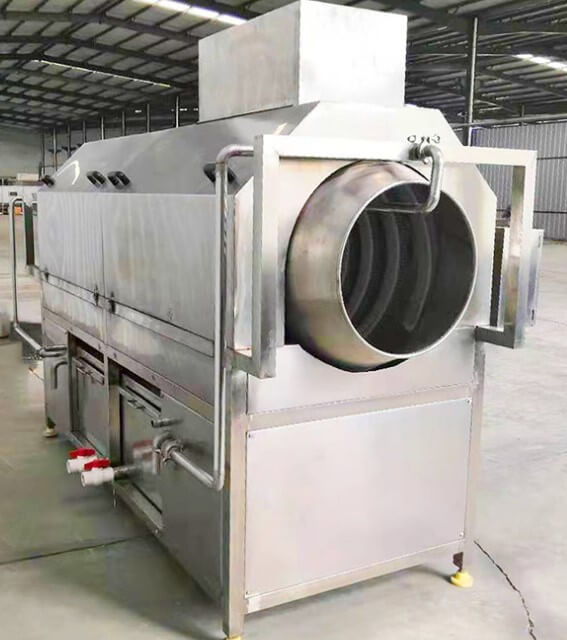
Soybean soaking machine
The purpose of soybean soaking is to soften the cell structure, improve the dispersion and suspension of the colloid, increase the protein yield, and reduce the abrasion of the refiner. There are 3 technical processes for soaking soybeans. The first is to soak the soybeans in boiling water of nearly 100℃ for about 30 minutes with 2.5 times water; the second is to soak soybeans in hot water at 50-60℃ and add about 0.2% sodium hydroxide solution, soak for 2 hours; The third is to add 3 times the amount of room temperature water to soak soybeans for about 16 hours. In industrial production, hot water soaking is mostly used, which has good continuity and high efficiency. The soybean soaking machine is composed of soybean storage bucket, bean soaking tank, drain screen, frame and pipeline. The equipment is made of SUS304 material, and the production capacity is 200kg-2000kg per hour.

Vacuum soybean absorber
The vacuum bean suction machine is used to transport or lift fresh soybeans to the next station for further processing. The equipment is made of SUS304 material, and it consists of a vacuum bean storage bucket, a vortex air pump, and a bean conveying pipe. The raw materials (soybeans) are automatically transported from the warehouse and bean storage tank to the bean washer or refiner.

Triple soy milk refiner and fiber separator unit
The triple soybean milk refiner and fiber separator unit consists of water flow meter, bean flow controller, refiner, soy milk tank, hopper, electrical automatic controller, etc. The automatic control system is adopted to complete the whole process from feeding beans, adding water, soybean milk separation to defoaming processes. Three refiners refining increase the refining speed and output rate. When the bean storage bucket on the top of the refiner is full of soybeans, the sensor transmits the signal to the controller, and the bean suction pump automatically stops working. When the soybeans in the barrel fall to the lowest setting position, the bean suction pump automatically starts to work, so that the set bean storage capacity in the bean storage barrel is always maintained, ensuring the continuous operation of the refiner. The equipment is made of SUS304, and the production capacity is 500-2000kg/h.

Colloid mill+ Decanter extraction
There is another method to extract milk from soybean, which is using a wet cereal mill+ decanter centrifuge separator, this method is suitable for processing higher capacity soy milk ( soybean input capacity more than 2 tons per hour).
Firstly the soybean will be ground into soybean slurry by the colloid mill or grinding wheel, during the grinding process, the soybean and water ratio is about 1:5-10, after grinding, the solid content in soybean slurry is between 6.5%-11.5%, the solids recovery rate is 40%-55%. To increase the yield rate, there will be two-stage grinding process.
The liquid soya extract obtained from the grinding or extracting stage contains solids, which are referred to as sediments. Separation of soybean pulp and okara(fiber) after pulping can be carried out by using three-legged centrifuge or decanter centrifuge.
But when clients want to make whole-fiber soy milk products, there is no need decanter centrifuge separator to separate the fiber(okara) after the first grinding process of the soybeans. The general process is soybeans will be ground by the wet mill, and then pumped into the high-speed mixer inline with a homogenizer to obtain the more smooth soy beverage products.

Soy milk cooker/ Enzyme deactivation via heat treatment
Soybean milk cooker is an optional process, the main purpose is using high-temperature steam to heat soy milk/slurry to inactivate the enzymes to remove the beany smell in soy milk.
The equipment is mainly composed of a boiling tank, pipelines, heaters, valves, controllers, and defoaming devices. Use high-temperature steam to mix and heat the raw soybean milk, quickly inactivate lipoxygenase enzymes, sterilize, and can cook the soy slurry. It can be used for cooking pulp in the raw pulp process and cooking pulp in cooked pulp process. The cooking process adopts section temperature measurement and control, and the steam flow is adjusted by computer instructions to achieve the balance between the steam inlet and the slurry inlet flow. The cooking temperature is realized as set, so that the whole process of cooking is fully automated.

Soy milk blending and formulation tank system
The separated raw soymilk has high protein content, but the nutritional balance is worse than cow’s milk, and the flavor is not good. Therefore, it can be nutritionally supplemented and fortified as needed to prepare beverages with different flavors.
The purpose of mixing and formulation is to dissolve the hydrated raw materials, form stable fat emulsions, disperse small particles and reach the proper viscosity and tissue of the soy milk.
The preparation of soy milk is generally carried out in a SUS304 mixing tank. The soy milk, syrup, RO water, nutrition fortifiers, flavors and spices are mixed together, and the mixture is fully stirred. As the soya beverage is foamy products when mixing, the vacuum mixing tank is preferred to use to decrease the air and foam during the mixing. The mixing tank is a three-layer, which can be heated by steam or electricity, equipped with a level gauge, temperature sensor, manhole, sampling valve, CIP cleaning ball, etc.
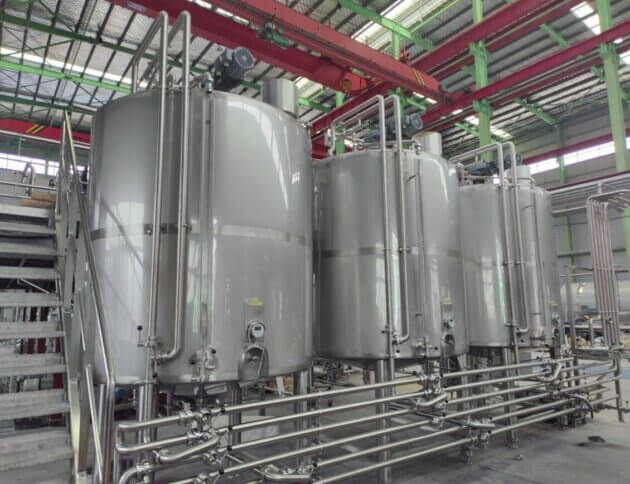
Soy milk homogenizer, degasser and sterilizer unit
Soymilk’s deodorization, homogenization, sterilization and cooling can all be completed in this process.
The main purpose of deodorization is to remove the peculiar smell left during the heating process and the pretreatment process. In the previous process, the high temperature and high-pressure soy milk enters the vacuum deodorization tank, and the pressure drops rapidly, which causes the steam with beany smell and peculiar smell to be quickly removed. The vacuum degree of the vacuum degassing tank is controlled at 26.7-40kpa, and the temperature is below 75℃.
The sterilization of soymilk is mainly to kill heat-resistant bacteria and trypsin inhibitor, using UHT tubular sterilizer/DSI sterilizer at 140-150℃, holding for 3-5S sterilization process.
The temperature of the sterilized soymilk is reduced to about 65℃, and then it is homogenized in the homogenizer, and the homogenization pressure is about 40-60Mpa to avoid the “sandiness” of soy milk after heat treatment and achieve the desirable mouthfeel. After the homogenization is completed, the soymilk is cooled to the filling temperature.
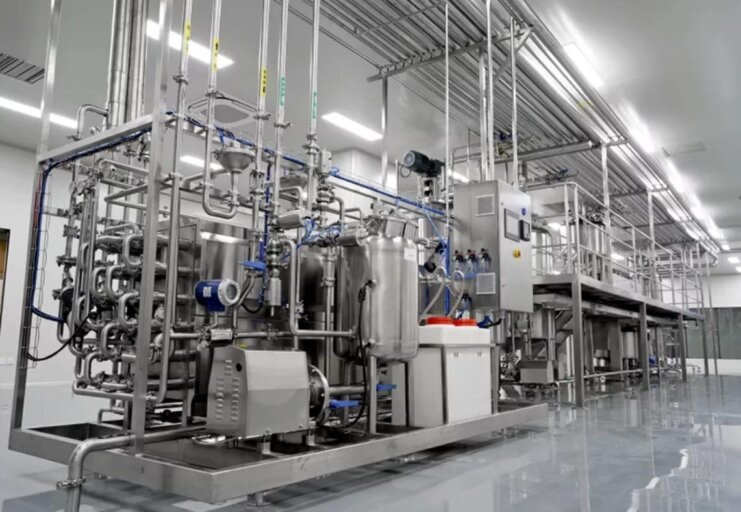
Soy milk filling machine
Soymilk is packaged in glass bottles or soft flexible pouches. After filling, the beverage needs to be secondary sterilizing at 121℃ to make the product reach a commercial aseptic state. The shelf life of the soymilk produced by this process is more than 6 months.
Another form of packaging is aseptic carton packaging. After the soy milk is filled, it does not require secondary sterilization and can be stored for more than half a year at room temperature.

